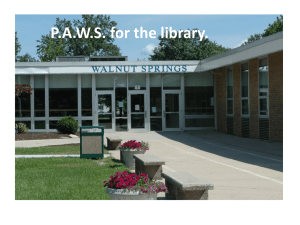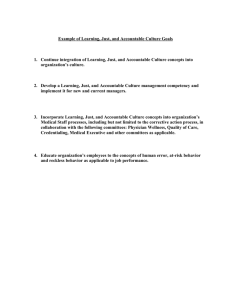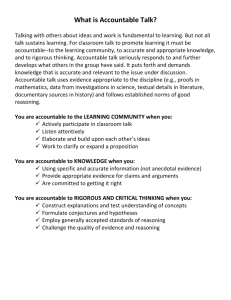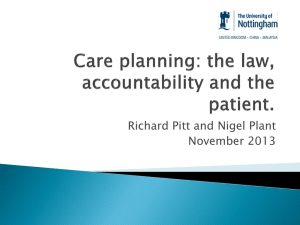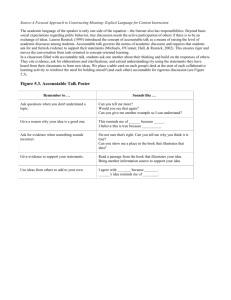Accountable Talk Toolkit: Classroom Discussion Strategies
advertisement
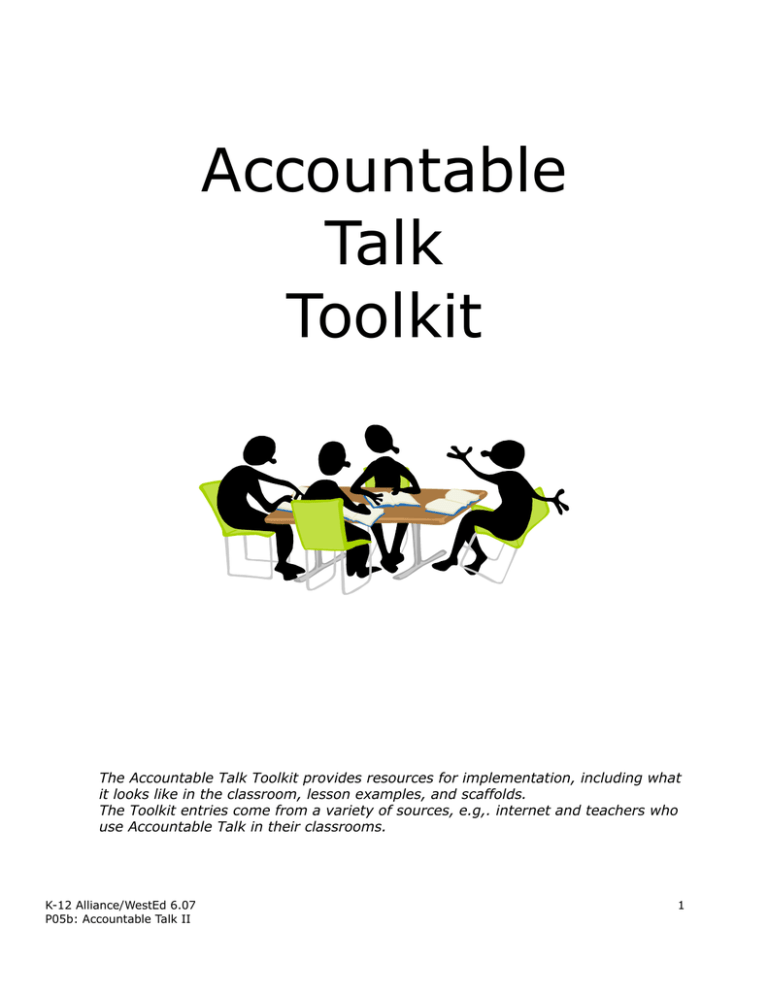
Accountable Talk Toolkit The Accountable Talk Toolkit provides resources for implementation, including what it looks like in the classroom, lesson examples, and scaffolds. The Toolkit entries come from a variety of sources, e.g,. internet and teachers who use Accountable Talk in their classrooms. K-12 Alliance/WestEd 6.07 P05b: Accountable Talk II 1 Questions to consider while planning for Accountable Talk What are the key concepts I want my students to learn in this lesson? What are the big ideas I want them to grapple with? How do these ideas relate to what we've just done? What instructional task will support the accomplishment of the purpose? Will this question or problem work best as a whole group discussion, as small group work, or as partner work? Should I set this topic up with a whole group discussion and then stop at a certain point and have the students turn and talk with partners? If so, precisely when should I tell them to do partner talk? What question should I have them think about with their partner? What classroom management issues do I consider? How will I keep the group or partner talk meaningful? What response stems are appropriate for the context and content of the lesson? What expected student responses should I prepared for and how will I address them? K-12 Alliance/WestEd 6.07 P05b: Accountable Talk II 2 Essential Features of Evidence Based Accountable Talk Moving from Teacher Control to Student Centered Range of Variations Teacher directs all Teacher models and Students work without decisions about AT, scaffolds how to select scaffolds, whole class, Essential whole class, small appropriate prompts in small groups or w/ Features groups or partners partners Teacher asks whole class, From modeling, students Students ask for evidence Learners hold each small groups or partners ask for evidence that that relates to content in other accountable forfor evidence that relates to relates to content and any context and select understanding. content. make some decisions appropriate Focus Teacher selects Focus about the selection of Questions and/or Questions and/or appropriate Focus Response Stems Response Stems. Questions and/or Response Stems Possible Prompts: What evidence do you have to support that? Clarify what you mean by __. Focus Questions and Based on my evidence, I think ___ . How could you prove that? Response Stems Where did you find that evidence? What is your line of evidence? Teacher uses appropriate From modeling, students Students select Focus Learners link or Focus Questions and/or use Focus Questions and/ Questions and/or expand their talk to Response Stems to link or or Response Stems to link Response Stems to link what others say expand on student’s or expand on student’s or expand on another statements OR asks whole statements – showing student’s statementgroup, small groups, they can apply cards in an showing they listened, partners or individuals to appropriate place. understood, and can expand on a student’s build on knowledge. statement. Possible Prompts: I want to add to what __ said __. An example of __ is ____ . Focus Questions and The relationship between __ and __ is __ . Response Stems Your evidence is the same/different because __ . How can you apply what you know about ___ to this new situation? The evidence is supported by __ . From modeling, students Students select ask questions of other appropriate Focus students or make Questions and/or comments, related to the Response Stems to ask strength of the evidence other students questions using appropriate Focus or make comments Questions and/or related to the strength of Response Stems. the evidence. Possible Prompts: I disagree with that because __. Focus Questions and I disagree with the use of that evidence because ____ . Response Stems Compare your evidence with the evidence from another group. I agree with ____ because ____ . Where did you find that evidence? I still have questions about ____ . I don’t know what you mean by __ . Based on my evidence, I think ___ . Compare the risk/benefit of ____ . Learners demonstrate skepticism, holding others accountable for thinking. Teacher asks whole group, small groups or partners questions related to the strength of the evidence using appropriate Focus Questions and/or Response Stems. Italics=scaffolds K-12 Alliance/WestEd 6.07 P05b: Accountable Talk II 3 Accountable Talk sharpens students' thinking by reinforcing their ability to build and use knowledge. Teachers create the norms and skills of Accountable Talk in their classrooms by modeling appropriate forms of discussion and by questioning, probing, and leading conversations. Accountable Talk Within a Classroom Setting Classroom Environment: Students' talk is appropriate in tone and content to the social group and setting and to the purpose of the conversation. Students allow others to speak without interruption. Students speak directly to other students on appropriate occasions. Students listen attentively to one another. Students actively participate in classroom talk. Each student is able to participate in several different kinds of classroom talk activities. When appropriate, students make references to previous speakers. A high percentage of classroom talk is by and among students. Students test their own understanding of concepts. Students redefine or change explanations. Students ask questions that test the definition of concepts. Students draw comparisons and contrasts among ideas. Students identify their own bias. Students indicate to what degree they accept ideas and arguments. Students feel safe to express ideas. Students participate in various forms of Accountable Talk, such as instructional discussions, whole class discussions, small group work, peer and studentteacher conferences, presentations, and interviews. K-12 Alliance/WestEd 6.07 P05b: Accountable Talk II 4 Accountable Talk Within a Classroom Setting Common Language around Accountable Talk: 1. Students make use of specific and accurate knowledge. Students make specific reference to a text to support arguments and assertions. Students make clear reference to knowledge built in the course of discussion. Examples or claims using outside knowledge are accurate, accessible, and relevant. 2. Students provide evidence for claims and arguments. Unsupported claims are questioned and investigated by discussion participants. Requests are made for factual information, elaboration, rephrasing and examples. Students call for the definition and clarification of terms under discussion. Students challenge whether the information being used to address a topic is relevant to the discussion. 3. Students identify the knowledge that may not be available yet which is needed to address an issue. K-12 Alliance/WestEd 6.07 P05b: Accountable Talk II 5 Accountable Talk Within a Classroom Setting Classroom Situations: Accountable Talk occurs during any phase of a learning sequence or lesson cycle, before, during or after students conduct investigations, solve problems, read or write about content. 1. Students synthesize several sources of information. Students refer to a variety of texts as sources of information. Students connect ideas within and between texts. Students use previous knowledge to support ideas and opinions. 2. Students construct explanations. Students acknowledge that more information is needed. Students use sequential ideas to build logical and coherent arguments. Students employ a variety of types of evidence. 3. Students formulate conjectures and hypotheses. Students use "what if" scenarios as challenging questions or supporting explanations. Students formulate hypotheses and suggest ways to investigate them. Students indicate when ideas need further support or explanation. 4. Classroom talk is accountable to generally accepted standards of reasoning. Students use rational strategies to present arguments and draw conclusions. Students provide reasons for their claims and conclusions. Students fashion sound premise-conclusion arguments. Students use examples, analogies, and hypothetical "what if" scenarios to make Arguments and support claims. Students partition argument issues and claims in order to address topics and further Discussion. 5. Students challenge the quality of each other's evidence and reasoning. The soundness of evidence and the quality of premise-conclusion arguments are assessed and challenged by discussion participants. Hidden premises and assumptions of students' lines of argument are exposed and challenged. Students pose counter-examples and extreme case comparisons to challenge arguments and claims. 6. Classroom talk is accountable to standards of evidence. K-12 Alliance/WestEd 6.07 P05b: Accountable Talk II 6 Accountable Talk Within a Classroom Setting Responsibilities/Roles: Students' body language/eye contact shows attention. Speakers' comments are connected to previous ideas. Students avoid multiple conversations. Students’ interest is in the whole discussion, not only in their own turn taking. Students elaborate and build upon ideas and each others' contributions. Talk remains related to text/subject/issue. Related issues or topics are introduced and elaborated. Talk is about issues rather than participants. Students work toward the goal of clarifying or expanding a proposition. Students summarize, paraphrase each other's argument(s) Students make an effort to ensure they understand one another. Students clarify or define terms under discussion. K-12 Alliance/WestEd 6.07 P05b: Accountable Talk II 7 Accountable Talk Response Stems Examples I disagree with that, because ____ . I agree with _____, because ____ . I still have questions about ____ . I want to add to what _(name)__ said about___. Based on my evidence, I think ___ . K-12 Alliance/WestEd 6.07 P05b: Accountable Talk II 8 I don’t know what you mean by ___ . Compare the risk/benefit of______ . I disagree with the use of that evidence, because _____ . A question I have is _______ . An example of ____ is _______ . Your evidence is the same/different, because ___ . K-12 Alliance/WestEd 6.07 P05b: Accountable Talk II 9 The relationship between ____ and ____ is ______ . This reminds me of _____ . I predict ______, because _______ . I understand __________ . When we ______, it helped me understand ________ . K-12 Alliance/WestEd 6.07 P05b: Accountable Talk II 10 The big idea is _____________ . This is different, because ______ . This is the same, because ________ . I observed ____________ . I’m confused by ______________. To expand on what ____ said __________ . K-12 Alliance/WestEd 6.07 P05b: Accountable Talk II 11 Accountable Talk Focus Questions Examples of Questions/Prompts Compare your evidence with the evidence from another group. Clarify what you mean by _______ . What evidence do you have to support that? How could you prove that? How can you apply what Where did you find that you know about ___ to evidence? this new situation? How does the evidence support ____ ? K-12 Alliance/WestEd 6.07 P05b: Accountable Talk II What is your line of evidence? 12 What are some ways you What tools will you can describe need? How will they help your method to us? you? What information do you What have you learned have? or found out today? How would you match ___ with ___? What is a counterexample? What do you need to find What strategies are you out in order to solve the going to use? problem? K-12 Alliance/WestEd 6.07 P05b: Accountable Talk II 13 What does the graph tell If the ______ continues you? to ____, what will be the result? How did you reach that conclusion? What if you had started with ___ rather than ___? What assumptions are you making? Have you thought of all the possible solutions? How can you be sure? Explain the pattern you Is that true for all made. cases? Explain. K-12 Alliance/WestEd 6.07 P05b: Accountable Talk II 14 Summarize your findings. What might be a more efficient strategy? What can you do to test What is the relationship your idea? between ___ and ___? What do you think caused the ____ to _____? How are ___ alike? How are they different? Based on what you know, Do you agree? what can you predict Why or why not? about _____? K-12 Alliance/WestEd 6.07 P05b: Accountable Talk II 15 What is the best sequence for ____ ? Why did you decide to organize your data/ results like that? Which idea would you reject? Why? Design a new problem or investigation for _____. Imagine what ___ would From what we have be like if there were learned, what other no____ . examples of ___ can you cite? What are some possible If the ____ continues to solutions to this ___ what will be the problem? result? Example of a lesson (as presented in instructional materials) and then showing how AT can be embedded throughout the lesson. K-12 Alliance/WestEd 6.07 P05b: Accountable Talk II 16 Accountable Talk in a 5E Lesson Lesson Concept: Chemical changes cannot be separated by ordinary means. Physical changes can be separated by ordinary means. Teacher Does Guides review from previous lesson. Shows a pictures of a large puddle and then the same area with no puddle. Prompt: Place the picture cards of water cycle in a sequence that explains where the water has gone. Ask: Where does the energy to evaporate all that water come from? What is the source of the heat? Explain how you know. Explain that energy from the Sun, called solar energy, provides the energy to change liquid water into water vapor. Student Does Accountable Talk Small Group Ask students to review and Think-Pair-Share: Organize the pictures to Organize show the events/sequence that occurs Compare during evaporation. Question: Compare your sequence to groups Expected Student Response around you. Do you notice similarities/ (ESR): differences? The Sun. or Heat. Or AT Stem: Their sequence is the same/ Energy. different, because _____. We notice _____. Please clarify why you have this here. Share out whole group. We have seen the impact of heat energy on water. Today Small Group we are going to compare how heat energy affects solid matter as well. Observe Distribute samples of earth materials, water and soil, and ask students to make general observations. Predict Review that the term Earth materials refers to nonliving substances that make up the Earth (e.g. water, rocks, minerals, sand, gravel, air) ESR: They will get hot. They will heat up. Display a few types of matter and tell them that each type has a different rate of absorbing heat energy. Some ESR: They will not be as heat-up faster than others and some retain heat longer hot. They will cool down. than others. Prompt: Predict some possible outcomes for the soil and water temperatures as they are placed in the sun. Questions/Prompt: Predict which you think will happen when water and soil is placed in the sun. How might the temp. of the water and soil compare when they are in the sun and the shade? AT Stem: I predict ____, because _____. The temp will be the same/different, because ____. Display the prompt/response stems on the board. Chart predictions for students. Explain that they will now have the chance to test their predictions. Small Group Conduct experiment Record on data sheet. AT Stems/Questions: The thermometer shows/measures ____. I am confused by _______. How do you come to that result? I notice ____. Ask students to measure water and soil in cups and place Record data-both a thermometer in cups. Record starting temp and place in qualitative and quantitative the sun for 30 minutes. Record temp every three minutes (Listen for qualitative and quantitative for 15 minutes and record on data sheet. Place in shade responses). and wait for 30 minutes. Record temp every three minutes and record on data sheet. Discuss I&E: same amount of solid and liquid matter, tools for measurement, time intervals, recording sheet, qualitative and quantitative data Whole Group Model how to set-up an accurate plot graph: title, time intervals, units of measurement, key, how to draw lines Analyze results Write a data summary Graph results. Discuss and analyze the data from the graphs. Ask students to discuss Focus Questions. ESR: Both samples were exposed the same amount of time. The soil got hotter. Next Step: Over the next few weeks, we will be learning about weather. The experiment that you conducted today will help us to understand why we have different weather patterns on the Earth. Adapted from FOSS, Water Planet, 2007 CA Edition K-12 Alliance/WestEd 6.07 P05b: Accountable Talk II After graphing use Focus Questions in pairs: How does the data on water compare with the data on soil? Which material heated up the fastest? How does your evidence support what you thought would happen? What is your evidence that _____? AT Stems: The rate of soil/water temp. increase/ decrease, because _____. The rate of soil/water temp. is the same/ different, because _____. We notice _____. Please clarify _______. Based on my evidence __________ . I want to add to what ____ said ______ . A question I still have is _______ . 17 Levels of Questions INPUT complete count define describe list locate match name observe recite select tell identify PROCESS analyze explain sequence compare analogy summarize estimate arrange separate combine invent relationship distinguish produce report classify infer cause/effect construct plan use arrange group show contrast organize synthesize write OUTPUT evaluate expand extrapolate project discuss imagine judge predict decide apply build choose create generalize principle model speculate forecast recommend hypothesize Excerpt from: K-12 Alliance/WestEd 6.07 P04a: Questioning K-12 Alliance/WestEd 6.07 P05b: Accountable Talk II 18 Template for Including Accountable Talk Accountable Talk Notes Teacher Does K-12 Alliance/WestEd 6.07 P05b: Accountable Talk II Student Does Accountable Talk 19
